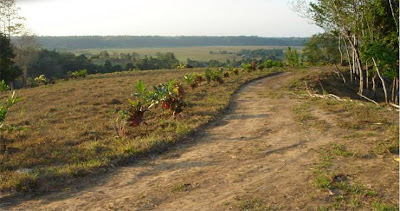After this, they built the temporary enclosures for the goats and sheep which were freely roaming before in the open field. When the animals were finally corralled, they started transplanting some of the hardy plants into their new location.
Here's what the dirt road looks like now after the dust has finally settled.
Along the sides of the road, they have started to transfer some of the plants they were propagating in the garden 'nursery'. The plants are now growing directly on the ground, their roots have been liberated from the confines of the black plastic bags.

The rough road then goes straight and curves once again. On the right side, the young black bamboos have been transplanted along this stretch of the road.

They planted a few ornamental plants on both sides of the path. As they mature, they will soften the stark look of the rough road. This path curves to the left...

... and from here it goes to the highest part of the farm. This path branches to the left right after the trees. The straight path continues all the way to the very end where it also veers to the left...
But they are not done yet with the partial landscaping. There are still a substantial number of plants left in the nursery. They are being kept there for the mean time while the dry and hot summer, aggravated by the drought brought by 'El Nino', has its firm grips over the land.

This path parallels the cliff. From here the river below can be seen. Right below this cliff is the 'ledge'.
There are no irrigation or sprinkler system, not even a single faucet on the upper level of the farm so watering the plants are done manually. The men have to carry on their shoulders large buckets of water that they fetch all the way from the lower level. Then one by one they water the plants. They repeat this process until every plant is watered.
Before, when the plants were still concentrated in the nursery, watering them was already a time-consuming task. Now that the plants are already scattered all over, the task has become even harder.
I'm still thinking of a way to remedy this water-shortage problem.



